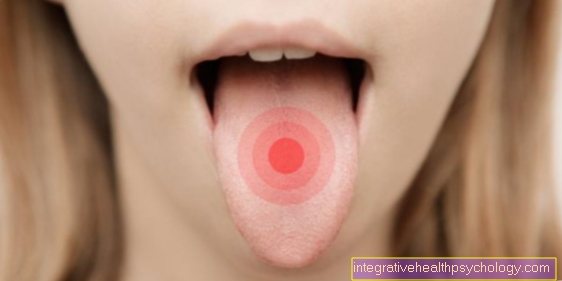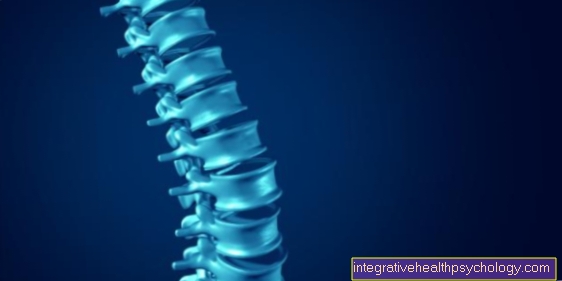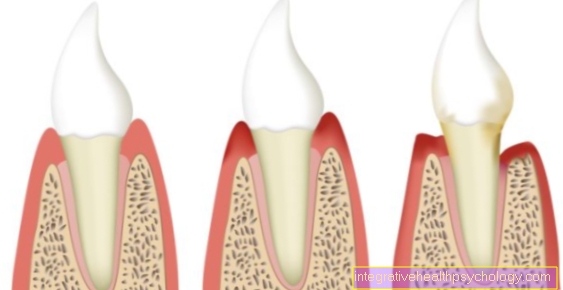Antidepressants - What drugs are there?
Synonyms
Thymoleptic, English: antidepressant
definition
An antidepressant is a psychotropic drug with an antidepressant effect. In addition to depression, it is also used in the treatment of e.g. Anxiety and obsessive-compulsive disorders, panic attacks, chronic pain, eating disorders, listlessness, sleep disorders and post-traumatic stress syndrome.
There are many different classes of active ingredients that differ in their mechanism of action as well as their main effect, side effects and interactions with other drugs.
An antidepressant can have a mood-enhancing and stimulating effect, but it can also have an anxiety-relieving and calming effect.

Classification
The classification of antidepressants is based on their mechanisms of action.
An exception are "tricyclic and tetracyclic antidepressants"(TZA). They are named for their chemical structure. In their function they are so-called "non-selective monoamine reuptake inhibitors"(NSMRI).
Only the most important classes are listed.
- Tricyclic and tetracyclic antidepressants (TCAs):
- Amitriptyline
- Clomipramine
- Doxepin
- Imipramine
- Nortriptyline
- Selective Serotonin Reuptake Inhibitors (SSRI):
- Citalopram
- Fluovoxamine
- Fluoxetine
- Paroxetine
- Sertraline
- Norepinephrine and serotonin reuptake inhibitors (NSRI):
- Duloxetine
- Venlafaxine
- Beta2 adrenoceptor antagonists:
- Mianserin
- Mirtazapine
- MAO (monoamine oxidase) inhibitors:
- Tranylcypromine
- Moclobemide
Tricyclic and tetracyclic antidepressants
The tricyclic and tetracyclic antidepressants are non-selective monoamine reuptake inhibitors (NSMRIs). They are divided into these two groups based on their characteristic chemical structure. By blocking transmitter channels, they non-specifically inhibit the re-uptake of noradrenaline and serotonin from the synaptic gap into the nerve cells.
Depending on the preparation, they show a stronger effect on the noradrenaline or serotonin transporters. The resulting increased concentration of the transmitters in the synapses increases the signal transmission and thus a drive-enhancing (mainly due to norepinephrine) and mood-enhancing (mainly due to serotonin) effect is achieved. At the same time, the preparations bind to numerous other receptors, which explains their wide range of side effects.
Tricyclic antidepressants include amitriptyline, clomipramine, and nortriptyline. While amitriptyline has an additional sleep-promoting effect, especially in depressed patients with sleep disorders, clomipramine has a strong anti-anxiety effect and nortriptyline has a strong drive-enhancing effect.
The tetracyclic antidepressants include maprotiline, mianserine and mirtazapine. In addition to the antidepressant effect, the latter above all have a sleep-promoting effect.
Selective Serotonin Reuptake Inhibitors (SSRI)
The selective serotonin reuptake inhibitors (SSRIs) only prevent the reuptake of serotonin from the synaptic cleft, which is why they have a strong mood-enhancing effect.
Since they do not bind to numerous other receptors at the same time, they have a lower spectrum of side effects and are better tolerated than the tricyclic and tetracyclic antidepressants. This is why they are one of the first choice antidepressants today.
They can also be used to treat anxiety, obsessive-compulsive disorder and eating disorders.
SSRIs include citalopram, escitalopram, fluoxetine, paroxetine, and sertraline. The most frequently prescribed SSRI in Germany is citalopram. It is superior to the other preparations, especially in terms of its weaker interactions with other drugs.
Citalopram
Citalopram belongs to the group of selective serotonin reuptake inhibitors (SSRIs). It has been the most frequently prescribed antidepressant in Germany in recent years.
Citalopram binds to serotonin transporters of nerve cells, which are responsible for the resumption of the transmitter. As a result, higher concentrations of serotonin are achieved in the synaptic gap, which corresponds to a mood-enhancing and antidepressant effect.
In addition, they do not bind to other receptors in the central nervous system, which explains the significantly lower spectrum of side effects compared to tricyclic antidepressants. Nevertheless, gastrointestinal complaints (with nausea, vomiting and diarrhea) and a loss of libido (sexual desire) can occur during the course of therapy.
Numerous other side effects are possible. In addition, the patient's sense of fear can initially be significantly increased in the first few days of therapy. Due to a simultaneous drive-increasing effect, there is an increased risk of suicide for the patient at the start of therapy.
Read more on the topic: Citalopram
Cipralex®
The drug Cipralex® contains the active ingredient escitalopram. This belongs to the group of selective serotonin reuptake inhibitors (SSRIs) and is structurally similar to citalopram.
In addition to being used for depression, Cipralex® can also be prescribed to treat panic, anxiety, and obsessive-compulsive disorders. Therapy must be continued for several months for successful treatment.
Escitalopram works by increasing the serotonin level in the central nervous system by blocking the serotonin transporters of the nerve cells. The increased serotonin level has a mood-enhancing effect. At the same time, the side effects that occur are largely due to the changed serotonin concentrations.
Similar to citalopram and fluoxetine, changes in weight (through a change in appetite), headaches, sleep disorders, dizziness (diarrhea, constipation, nausea, vomiting) and sexual dysfunction (ejaculation disorders, impotence) are possible.
Fluoxetine
Fluoxetine is a selective serotonin reuptake inhibitor (SSRI). The active ingredient leads to an increase in the serotonin level in the central nervous system, which has a mood-enhancing effect.
Compared to the tricyclic antidepressants that have been used for a long time, the SSRIs are characterized by a greater therapeutic range (lower risk of massive side effects in the event of overdose) and a smaller spectrum of side effects.
Frequent side effects are sexual dysfunction (loss of libido) and complaints in the gastrointestinal tract (nausea, vomiting).
At the beginning of therapy, the increased serotonin levels can also lead to an increased sense of fear and an increase in drive. Due to the delayed onset of a mood-enhancing effect after a few weeks, there is an increased risk of suicide for the patient. Regular checks by the attending physician are urgently required.
Selective Serotonin and Norepinephrine Reuptake Inhibitors (SSNRIs)
The selective serotonin and noradrenaline reuptake inhibitors (SSNRIs) only block the serotonin and noradrenaline transporters, which are responsible for the reuptake of the transmitters from the synaptic cleft.
They do not bind or bind only very weakly to other receptors. For this reason, compared to the tricyclic and tetracyclic antidepressants, it is characterized by a lower spectrum of side effects and better tolerability.
Together with the SSRIs, they are therefore the first choice for treating depression. They are primarily indicated for patients who offer an indication that enhances their mood as well as an indication that increases their drive. It should be noted, however, that the drive-enhancing effect can occur before the mood-enhancing effect, which at the beginning of the therapy brings with it an increased risk of suicide. For this reason, regular checks should be carried out by the attending physician, especially at the start of therapy with SSNRIs.
The SSNRIs mainly include venlafaxine and duloxetine. Similar to SSRIs, in addition to antidepressant therapy, they can also be used to treat anxiety, obsessive-compulsive and eating disorders.
Venlafaxine
Venlafaxine belongs to the group of selective serotonin noradrenaline reuptake inhibitors (SSNRIs). In addition to blocking serotonin and noradrenaline transporters, it does not bind to other receptors and therefore causes fewer side effects than the tricyclic antidepressants. Due to the additional binding to noradrenaline transporters, it has a strong drive-boosting effect. It is therefore primarily indicated for patients with an indication to increase drive and is the first choice. In addition to being used to treat depression, it can also be prescribed specifically for anxiety disorders (generalized anxiety disorder, social anxiety disorder, panic disorder).
The side effects of treatment with venlafaxine are similar to those of treatment with SSRIs. Very commonly, patients experience dizziness, headache, nausea, and dry mouth. In addition, a decrease in appetite (possibly with weight loss), sexual dysfunction, gastrointestinal complaints as well as visual and sleep disorders are possible.
α2 adrenoceptor antagonists
The activated alpha2 receptors usually ensure a reduced release of neurotransmitters. The so-called a2 adrenoreceptor antagonists block the alpha2 receptors, which means that they lose their activity and thus their inhibitory effect on the release of transmitters. As a result, there is an increased release of neurotransmitters.
The group of α2-adrenoreceptor antagonists includes mianserin and mirtazapine.
In addition to this effect via α2 receptors, they can also lead directly to increased amounts of serotonin and norepinephrine by blocking the channels for the reuptake of the transmitters. They are therefore also among the tetracyclic antidepressants. A special property of these active ingredients is their strong sleep-promoting effect. Therefore, they are mainly prescribed to depressed patients with an accompanying sleep disorder.
Mirtazapine
Due to its chemical structure, mirtazapine belongs to the class of tetracyclic antidepressants.
In addition to a slight blockade of serotonin and noradrenaline transporters for the resumption of the transmitters in the nerve cells, it also binds to α2 receptors on nerve cells, which increases the release of transmitters (including noradrenaline, serotonin and histamine).
Due to the increased release of norepinephrine and serotonin into the synaptic gap, it has a drive-enhancing and mood-enhancing effect. Due to the strong binding of mirtazapine to α2-receptors of histaminergic nerve cells (nerve cells that release histamine), it has a strong sleep-promoting effect.
For the treatment of depression with accompanying sleep disorders, it is therefore the agent of first choice and is often prescribed.
Compared to other antidepressants, mirtazapine is better tolerated and has fewer side effects.
Nevertheless, numerous side effects are possible, mainly due to the increased serotonin level.While side effects such as insomnia, restlessness, loss of appetite and sexual dysfunction occur much less frequently, patients often report an increase in appetite and weight, severe fatigue and a dry mouth.
MAO (monoamine oxidase) inhibitors
The MAO inhibitors work by inhibiting monoamine oxidase. This is an enzyme that is widespread in the body and is responsible for breaking down many transmitters (including norepinephrine, serotonin, dopamine).
Depending on the affinity to the transmitters, a distinction is made between two different forms of monoamine oxidases (A / B). Due to the inhibited degradation of the transmitters in the central nervous system, a larger amount of the transmitters can be released in the course of the signal transmission.
Two different drugs are used to treat depression: tranylcypromine and moclobemide. Due to their wide range of side effects, they are mainly used to treat therapy-resistant (with the above-mentioned groups of active substances) depression.
Tranylcypromine irreversibly inhibits MAO-A and MAO-B and therefore has a particularly strong effect. There is an increase in all transmitter concentrations. Instead, moclobemide only leads to a reversible inhibition of MAO-A. For this reason, the breakdown of the transmitters noradrenaline and serotonin is inhibited, which corresponds to an antidepressant effect.
Read more on the topic: MAOIs
Other antidepressant agents
- Lithium salts: Lithium salts such as lithium carbonate, lithium acetate, lithium sulfate, lithium citrate and lithium orotate are used therapeutically in various mood disorders like one bipolar disorder or at the depression used.
- Johannis herbs: The ingredients of St. John's wort Hypericin and Hyperforin presumably also have antidepressant effects.
Side effects of antidepressants
All antidepressants are characterized by a wide range of potential side effects. These occur especially at the beginning of therapy and subside over the course of treatment. Since the antidepressant effect is delayed after several weeks, these side effects are a frequent reason for premature discontinuation of therapy.
A particularly large number of side effects, some of them serious, can be found with treatment with tricyclic antidepressants (amitriptyline, clomipramine, nortriptyline). This is because, in addition to their affinity for the serotonin and noradrenaline transporters, these active ingredients also bind to numerous other receptors in the body. As a result, disorders of the heart function, deviations in blood pressure, severe weight gain (due to an increase in appetite) as well as dry mouth, constipation and numerous other side effects are possible.
In contrast, the remaining reuptake inhibitors bind exclusively to the body's serotonin and noradrenaline transporters. As a result, their side effects can only be explained by the increased transmitter concentrations. Frequent side effects are sexual dysfunction (with a loss of libido), gastrointestinal complaints, fatigue and a change in weight.
The MAO inhibitors, which are mainly used in depression that are difficult to treat, also have a wide range of side effects, as they affect a large part of all transmitters.
Read more on the topic: Side effects of antidepressants




.jpg)
























